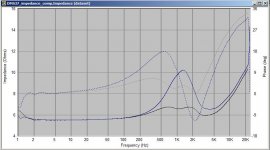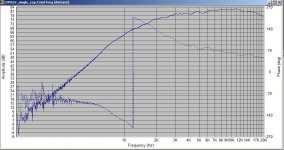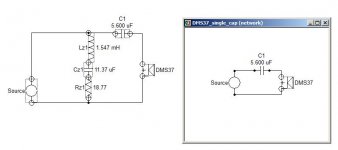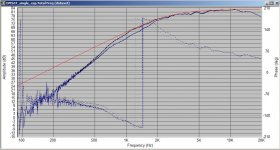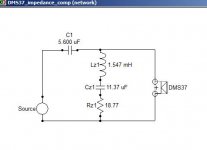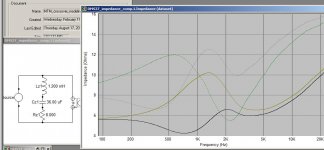I like that.
Djk always said a speaker's far field response mirror's its off axis response.
B102 would need stronger tweet if add R to morel.
Not many rugged tweets that have 92db and roll 6db slope (and down at) @2khz, and 700hz Fs good for first order slopes. That why I've kept my eye on that tweet.
I figured it could roll into a woofer without an inductor.
That way it would have an in phase step response.
Not quite time alignment, but pretty good (or better as you heard).
Only compression driver horn clean enough would be mcm round horn (diysound group now), but it too probably boosts 2-6khz also.
If i send you a driver plus horn could you measure it ?
Response and impedance?
It wouldn't be big.......
Djk always said a speaker's far field response mirror's its off axis response.
B102 would need stronger tweet if add R to morel.
Not many rugged tweets that have 92db and roll 6db slope (and down at) @2khz, and 700hz Fs good for first order slopes. That why I've kept my eye on that tweet.
I figured it could roll into a woofer without an inductor.
That way it would have an in phase step response.
Not quite time alignment, but pretty good (or better as you heard).
Only compression driver horn clean enough would be mcm round horn (diysound group now), but it too probably boosts 2-6khz also.
If i send you a driver plus horn could you measure it ?
Response and impedance?
It wouldn't be big.......
Last edited:
I could try but have nearly zero mobility to get it back to the post office - which driver and horn ?
2407 and mcm round horn, they are djk's.
Seemed fine 24db actively crossed LR @2khz, no hf needed.
Nevermind. It is a curiosity really.
Seemed fine 24db actively crossed LR @2khz, no hf needed.
Nevermind. It is a curiosity really.
(-if you could scrounge up a mic and preamp, then ARTA is free in its demo mode and does step response among other things) ARTA Software
Troles seems to think its fine to use 18-20ga wire in a tweeter notch filter ... how might a coil with low self resistance and higher Q in series with more R differ from a thinner wire coil with higher dcr and lower Q with same overall dcr ? Does the low dcr coil case apply only when there's R between the notch filter and the tweeter ? (Dayton's 1.2mH 20ga coil is rated 0.82 ohm dcr)
COILS FOR DIY LOUDSPEAKERS
Troles seems to think its fine to use 18-20ga wire in a tweeter notch filter ... how might a coil with low self resistance and higher Q in series with more R differ from a thinner wire coil with higher dcr and lower Q with same overall dcr ? Does the low dcr coil case apply only when there's R between the notch filter and the tweeter ? (Dayton's 1.2mH 20ga coil is rated 0.82 ohm dcr)
COILS FOR DIY LOUDSPEAKERS
Last edited:
I would not bother with impedance compensation on the cat378. I have the DMS37 (it's predecessor) these tweeters have ferrofluid and thus a very low impedance peak. Compensating it will result in virtually no difference.
also note that my examples had resonant peak nearly 400hz higher than the datasheet!
I ran sims to check what difference there might be. As you will see it's almost imperceptible.
Tony.
also note that my examples had resonant peak nearly 400hz higher than the datasheet!
I ran sims to check what difference there might be. As you will see it's almost imperceptible.
Tony.
Attachments
thanks wintermute - would the result be essentially the same if the compensation filter were directly across the tweeter and "after" the capacitor ? In general, what ratio of Z peak to Re does the interaction of the peak with an odd order highpass become a concern?
cool, no notch, that makes my parts express order even closer to happening.
good to hear on the b102.
Seems to stay more pistonic.
good to hear on the b102.
Seems to stay more pistonic.
Last edited:
Bugger i stuffed up with that! Teach me to sim before ive had my morning coffee! I'll get back to you. I thought it odd it made no perceptable difference! :embarrased:
Tony.
Tony.
Last edited:
Well that's a bit embarrasing!! 😱
I'll revise what I said to it will depend on your actual crossover!
See below the difference when it is implemented correctly 🙄 I added in an arbitrary goal that seemed the closest fit to the curve achieved with the 5.6uF cap. The blue is with the impedance compensation network.
The red curve is target of 2.6Khz 2nd order bessel at 83db.... Depending on what your goal was and how you chose to get there, the impedance compensation may make it better or worse! it clearly is reducing the spl in the resonant peak range, but whether this is a good thing or not will depend on the implementation.
Sorry for my posting of mis-information, and thank you freddi for questioning it!!
Tony.
I'll revise what I said to it will depend on your actual crossover!
See below the difference when it is implemented correctly 🙄 I added in an arbitrary goal that seemed the closest fit to the curve achieved with the 5.6uF cap. The blue is with the impedance compensation network.
The red curve is target of 2.6Khz 2nd order bessel at 83db.... Depending on what your goal was and how you chose to get there, the impedance compensation may make it better or worse! it clearly is reducing the spl in the resonant peak range, but whether this is a good thing or not will depend on the implementation.
Sorry for my posting of mis-information, and thank you freddi for questioning it!!
Tony.
Attachments
Thanks - (I'm on stale before bedtime Gevalia right "now") - its going to be 5.6uF with CAT378 and most likely the unfiltered Eminence B102 - I'd like to protect the tweeter. What happens if the values are set to around 1.2mH + 45uF-50uF + 6R-8R ? I'm just guessing from my graph below. I probaby can string something together and take a measurement.


Last edited:
- - would the filter do enough good to matter in reducing excursino? -
resonance looked pretty close to 600Hz on my sweep below (green trace)
it was hitting 4 ohms (yellow trace) with ~47uF, 1mH steel-core choke + 5.2R, but missing the target

resonance looked pretty close to 600Hz on my sweep below (green trace)
it was hitting 4 ohms (yellow trace) with ~47uF, 1mH steel-core choke + 5.2R, but missing the target

Last edited:
- - would the filter do enough good to matter in
If the primary concern is reducing excursion, then from the second sim with my DMS37 there is a reduction in SPL of around 3db with the notch at the resonant frequency (and that tapers off gradually over a fair distance iether side of the resonant frequency).
Whether this will help a lot, a little, or not at all I'm not sure.. What it might do is make your tweeter curve closer to your target acoustic response, but it could also make it further away. This is the real crux I would say. You can meet the target curve in multiple ways, and if one of those is using the notch then it may be an option, if you can meet the same target curve without the added complexity of the notch then I'd do that instead, because the excursion will be dependent on what the actual rolloff (regardless of the crossover topology to achieve that) .
Norman, not sure if you were asking me or freddi, but no I do not use a notch in my crossover with the DMS37.
Tony.
-sounds to me it may not be effective enough to be worth the expense & bother with regards to reducing dome excursion. Could a higher order passive filter sound just as good subjectively ?
Who knows.
steeper slope = Less distortion, but then you lose time alignment (phase alignment, step response).
Depends on what you are going for.
I'm surprised more havn't told us how bad a 6db filter sounds and is a waste of time.
time alignment has been a disappearing thing, even theil no longer does it.
That leaves Vandersteen, dunlavey, and a couple of more still doing it.
steeper slope = Less distortion, but then you lose time alignment (phase alignment, step response).
Depends on what you are going for.
I'm surprised more havn't told us how bad a 6db filter sounds and is a waste of time.
time alignment has been a disappearing thing, even theil no longer does it.
That leaves Vandersteen, dunlavey, and a couple of more still doing it.
Last edited:
(-fwiw, got a new midbass horn, not yet loaded, which sims 110dB 1pi 2.83v 1M with a $50 10" so got spl covered in one area.) B102 + CAT378 +5.6uF = some sort of speaker 😀 would 211 incandescent bulbs add some "protection" without excessive loss or coloration ?
were some Theil speakes of 30 years ago "1st" order"? - I only heard a particular early 3-way at a friend's house with vinyl and a Berning hybrid preamp - can't remember the amp - unless it was my little Bedini (?)
How's the BP102 thread coming along? -that also looked interesting tho w. larger lower xover WG
were some Theil speakes of 30 years ago "1st" order"? - I only heard a particular early 3-way at a friend's house with vinyl and a Berning hybrid preamp - can't remember the amp - unless it was my little Bedini (?)
How's the BP102 thread coming along? -that also looked interesting tho w. larger lower xover WG
Last edited:
I started with 2nd order bessel acoustic slopes in my instance, I was never 100% happy, it came unstuck at higher levels and with "high density" music... I never determined if it was the tweeter or the woofers that were the main problem though.
I changed to a 4th order bessel acoustic slope, and the difference was substantial. Well worth doing. Now it may be that I could have done a better 2nd order but that's my experience. There are possibly other factors such as the phase alignment being substantially better on the 4th order as well.
Note that even with just the cap you effectively have a slope which is greater than 2nd order bessel (at least with the DMS37 data) and even greater again than 2nd order LR...
In my case the drivers are time aligned (or very close to it). because of the horn loading the AC of the morel is actually behind the baffle, and if used with a shallow profile woofer can be very close to time aligned. In my case it is paired with morel MW-144's which are surface (rather than flush) mounted, and this gets near enough to time aligned.
To achive 4th order bessel (or LR, but I like bessel 😉 ) acoustic slope you actually only need a 2nd order electrical network on the tweeter. Can't comment on what is required for your woofer...
Tony.
I changed to a 4th order bessel acoustic slope, and the difference was substantial. Well worth doing. Now it may be that I could have done a better 2nd order but that's my experience. There are possibly other factors such as the phase alignment being substantially better on the 4th order as well.
Note that even with just the cap you effectively have a slope which is greater than 2nd order bessel (at least with the DMS37 data) and even greater again than 2nd order LR...
In my case the drivers are time aligned (or very close to it). because of the horn loading the AC of the morel is actually behind the baffle, and if used with a shallow profile woofer can be very close to time aligned. In my case it is paired with morel MW-144's which are surface (rather than flush) mounted, and this gets near enough to time aligned.
To achive 4th order bessel (or LR, but I like bessel 😉 ) acoustic slope you actually only need a 2nd order electrical network on the tweeter. Can't comment on what is required for your woofer...
Tony.
Last edited:
yea, thiels were all 6db till couple of years ago.
I had some model 04 then cs2.
couldn't tell you on the bulbs.
Havn't been following the bp102 thread.
I had some model 04 then cs2.
couldn't tell you on the bulbs.
Havn't been following the bp102 thread.
- Status
- Not open for further replies.
- Home
- Loudspeakers
- Multi-Way
- Morel cat378 plus rs180p........
